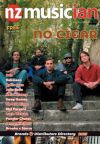Jazz Guitar Shed: 4 x4 – Chord Tones
Jazz Guitar Shed: 4 x4 – Chord Tones
After a couple of detours in recent NZM issues, it’s time to think about notes again. Our focus is on how to bring out the sound of the harmony when we solo over standard chord progressions (clue, the answer is not modes!) Weve looked at guide tones in previous articles. The next step is to look at the use of chord tones.
Chord tones are the root, 3rd, 5th and 7th of a chord (ie the 7th chord arpeggio).
Before you start, you need to make sure you know arpeggios for the chord types in the major scale: major 7th, minor 7th, dominant 7th, minor 7b5th. These are the basic chord types found in most mainstream jazz standards. There are plenty of places you can find this information (check my website if you’re stuck), and make sure you know at least two or three places on the neck to play each arpeggio. (Ideally youll be able to play them all over the fretboard.)
Let’s take a standard chord progression – well use the first 8 bars of All The Things You Are.
Example 1 shows you the basic chord tones for each chord. The chord tones for each chord are shown within one octave, with one possible way of playing them in TAB. (You should extend this to other octaves and explore other ways of playing the same notes).
Step 1 is to solo using chord tones over each chord. You don’t need to play on every chord and you dont need to play every chord tone, but every note that you do play must be a chord tone. (Example 2 – notice that sometimes the chord changes are anticipated, ie. played half a beat earlier.)
In Step 2 you are still restricted to chord tones, but this time you have to play every chord tone at least once on each chord, in any order. (Example 3 – in this example, I have extended the chord tones into different octaves occasionally.)
Develop melodies. Be musical. Take risks. This is not just an exercise. Find connections (eg. common tones, moving to the next chord by a semi-tone etc.) Be creative.
A word of caution however. Although I am encouraging you to think about notes that fit with each individual chord, the aim is to play lines that connect the chords together. Your goal is to weave phrases through the chord changes as seamlessly as possible. I mention this now, because once you start working with chord tones, you need to take care not to fall into the sounds like an exercise trap! You are trying to make a melodic statement that brings out the sound of the harmony as much as possible. What you play is guided by the chord changes, but melody is key.
A couple of other thoughts.
1. Soloing using chord tones often involves wide intervallic leaps – these sound great but can be tricky to play. (Thinking note names rather than shapes will make this easier.)
2. You could try restricting yourself to one position/area of the fretboard, or maybe a specific set of strings (eg. just the B and G strings).
Gaining control over chord tone soloing is a very important part of learning to improvise over chord changes. If you need any proof, legendary guitarist Mike Stern talks about this in pretty much every masterclass he gives (usually demonstrating it over Autumn Leaves), whilst Pat Metheny reckons about 50% of the melodic content of his soloing is chord tones.
Some homework:
a.) Be sure you know major 7th, minor 7th, dominant 7th and minor 7b5th arpeggios in at least 6th and 5th string root shapes. Take some time to memorise these if you dont know them already, but don’t spend ages just running up and down them as fast as you can. Dive in and use them in a musical situation as soon as you can.
b.) Take a section of a standard tune you are working on and work out the chord tones.
c.) Practice soloing over the tune using the steps detailed above (over a backing track or, even better, with some human beings!)
Have fun with this, and I’ll see you next issue.
Dylan Kay is a professional guitarist and teacher based in Auckland. He can be contacted through his website www.dylankay.co.nz

